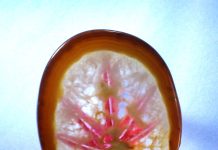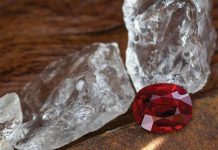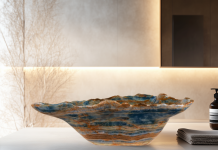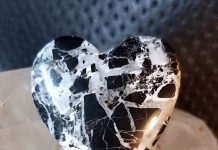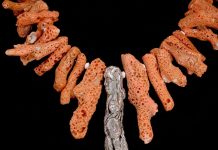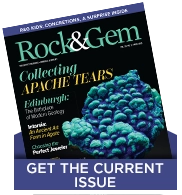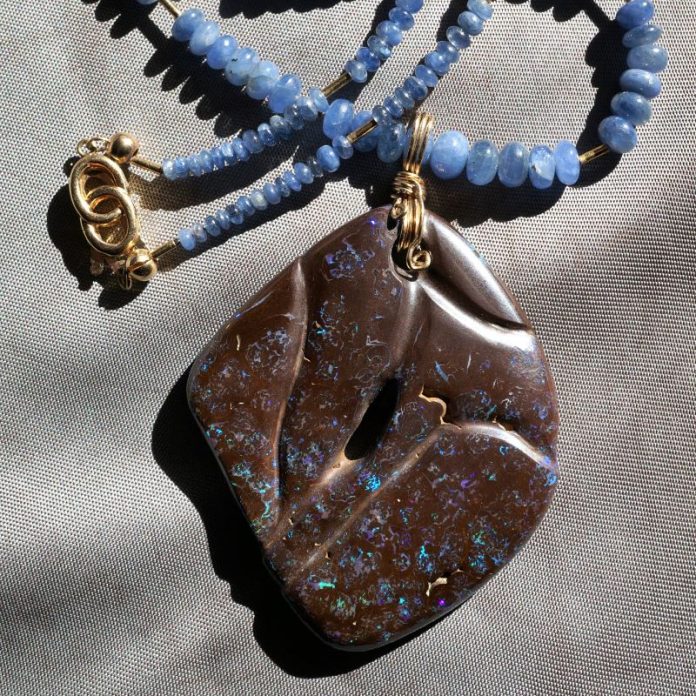
Brown gemstones are skyrocketing in popularity, with Mocha Mousse being named the Pantone® Color of the Year.

Mocha Mousse is a warm, sophisticated, earthy brown hue permeated with a richness that ties in perfectly with hues of natural copper specimens and a number of gems and lapidary materials. These include smoky quartz, scenic jaspers, boulder opals, champagne topaz, chocolate tourmalines and diamonds, and chocolate-colored pearls, some natural while others treated. Brown gemstones range from deep brown to rich chocolate brown to warm caramel brown and tan, touching almost every mineral group.
1. Copper
Copper is a chemical element (Cu). This soft, malleable and ductile metal has been mined since antiquity worldwide. Well-defined native copper specimens are highly valued.
Today’s copper mines, mostly open pits, mine the copper ore, which also includes small amounts of gold and silver, separated when it’s sent for smelting. The largest copper mines and deposits in the U.S. are in Keweenaw Peninsula in Michigan and several mines in southern Arizona. Copperin-quartz is a favorite cabbing material.
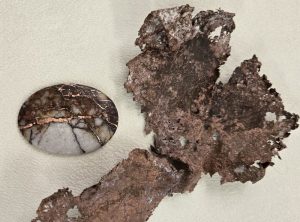
Courtesy Helen Serras-Herman
A wonderful museum, dedicated to all types of copper artifacts and copper’s history, is the Arizona Copper Art Museum in Clarkdale, in northern Arizona.
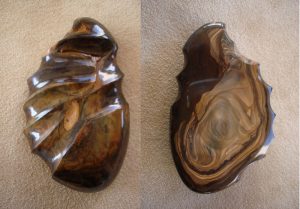
Courtesy Helen Serras-Herman
2. Crystalline Quartz & Jaspers
The quartz family includes several crystalline quartz and cryptocrystalline jasper members that match Mocha Mousse. Smoky quartz ranging from dark brown to yellowish-brown is a classic example, as well as natural-color brownish banded agates.
Brown picture jaspers that depict desert and mountain sceneries include the famous jaspers Bruneau, Biggs, Owyhee, Sunset Owyhee, Porcelain, Yellow Feather, and Royal Sahara Jasper®. All jaspers belong to the cryptocrystalline group of quartz, with a hardness about 6.5 Mohs. These dense, opaque jaspers are prized for their uniformity, not too many pits, and for taking a great polish.
Bruneau Jasper
Bruneau jasper is a rare variety from Idaho. Discovered in the 1940s, its overlapping egg-shape patterns made this variety legendary as they create a unique visual pattern not seen in many other jaspers. The more perfect the circular patterns, the higher the value of the specimen. Color often gradually changes from the outer edges to the center.
Biggs Jasper
Biggs jasper was first discovered around 1960 at the bottom of a creek near Biggs Junction in Oregon. Its complex geology origin is reflected in the marbled, rosette-like patterns, dark swirling bands and landscape picture designs that make this jasper famous. It may also display beautiful dendritic inclusions. Biggs jasper is a highly-prized variety both by lapidaries and collectors. With very similar but tighter patterns is Deschutes jasper from Oregon, also frequently with black dendritic inclusions.
Owyhee Picture Jasper
The Owyhee picture jasper, considered by many the “king of jaspers,” comes from the Owyhee Mountains on the Idaho/ Oregon border. Colors include tan to chocolate-brown with red splashes, often against a light bluish background, frequently staged in creatively designed cabochons as “blue sky” against the “rolling desert hills.” Newly mined material is rare today.
Royal Sahara Jasper
Royal Sahara Jasper® was discovered in 2006 at the Sahara Desert in Egypt. It is one of the toughest, fine-grained jaspers, with a terrible outer muddy layer that has to be ground down to the jasper core. Rounded nodules hide inside swirling brown to tan patterns, often with beautiful dendrite inclusions.
Brown Gemstones Quartz Varieties
A few more quartz varieties match Pantone’s Mocha Mousse: Pato De Gallo agate, a rare variety from Durango, Mexico, mostly mined in the 1970s; Yellow Feather jasper from Utah with some reddish colors due to iron inclusions and manganese oxide dendrite feathers; and some Florida agatized coral specimens. Porcelain jasper is another variety with swirly, intricate patterns resembling porcelain ceramics. This brecciated porcelain jasper from Sonora, Mexico, features cream, gray, purple and pink colors with exotic patterns and some black dendrites. Mookaite, also known as Mooka jasper, is actually a multi-colored chert (a cryptocrystalline quartz variety), often with chocolate-reddish-tan colors, with hardness 6.5 to 7.0 Mohs scale of hardness. It is found at Mooka Station, 150 kilometers East of Carnarvon, 600 kilometers north of Perth in Western Australia.
A rare flint variety from the Greek island of Kefalonia is a historic variety used in ancient times for engraved seals and tools because the nodules could knap off easily. Its carnelian-chocolate color is another brown gemstones close match to the Mocha Mousse color.
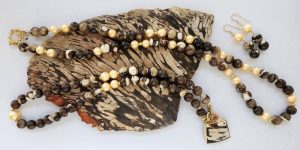
Courtesy Helen Serras-Herman
“Peanut” Teredo petrified wood, also known as “Shipworm wood,” exhibits a chocolate-brown background interspersed with borer holes formed by Teredo marine bivalve mollusks (commonly known as shipworms), filled with white or yellow silica. This rare petrified wood comes from the Lower Cretaceous Windalia Radiolarite Formation, near Mooka Station, in Western Australia.
Rocks from the Great Unconformity – the 900-million-year erosional gap in the geologic record found around the world and north of Payson, Arizona, exhibit on the bottom layer a granitic rock composed mostly of quartz, feldspar, and epidote, and on the top a sedimentary rock, a siltstone containing some quartz. When cut, these brown gemstones produce Mocha Mousse chocolate-tan color churned patterns.
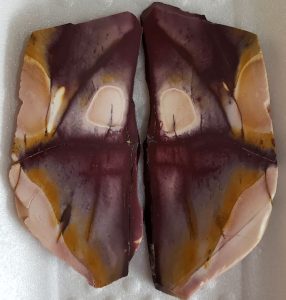
Courtesy Helen Serras-Herman
3. Chocolate Tourmaline
Tourmaline is a crystalline silicate mineral group with specimens that come in every color of the rainbow, including black, depending on the elements of iron, aluminum, magnesium, sodium, lithium or potassium. The brown gemstones variety is known as dravite, named after the Drava River in today’s Republic of Slovenia. It is a sodium-magnesium tourmaline member. Beautiful crystals, often short and stubby, also come from Nepal, Russia and Brazil, which may produce stunning large faceted brown gemstones.
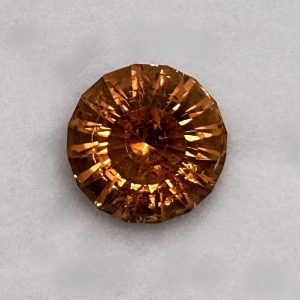
Courtesy Bernie J. Emery
4. Boulder Opal
The most common form of boulder opal is seam boulder opal. It forms when irregular natural opal seams run through the ironstone matrix host rock. When this brown gemstone material is cut, the opal layer rests on the ironstone, usually creating two visually distinct layers.
Boulder matrix opal is formed when very thin natural opal seams penetrate the entire host rock (matrix) and become a mixture of opal and ironstone, creating dazzling patterns. This type of opal differs from the other matrix opals such as Andamooka, Honduras and Mexican matrix opal.
Queensland Locations
Several locations in Queensland, Australia, produce boulder matrix opal. Each one is almost identifiable by the formation and patterns in the opal.
One of the oldest boulder matrix opal mining locations since 1884 and probably the most famous one is Yowah, in southern Queensland. The name, probably of Aboriginal origin, reflects the nearby Yowah Creek. Less than 200 kilometers away is Koroit, where opal was first discovered in 1897. Zigzag and flame patterns run throughout Koroit opal making for a fireworks display.
Some of the ironstone matrix, both in Yowah and Koroit stones, has higher iron content and possibly more silica, like red jasper. If you gently tap two stones, they make a ringing sound. That material is hard and polishes to a mirror finish. Other material may just finish to a glossy surface.
Winton Opal
Winton opal, from Winton in the northern part of Queensland, is an unusual boulder matrix opal believed to be opalized wood limbs; it exhibits bright rainbow flashes throughout the matrix.
A wonderful opal material referred to as “chocolate opal” came from a location about three miles outside of Yowah. It is boulder matrix opal with brightly-colored fine opal veins in what the opal miners call the “biscuit band” (flaky sandstone). The material can produce fabulous cabs and carvings, but it is really hard to work with, as the opal seams are thin and can vanish in a flash while grinding; some of the matrix may also be too soft.
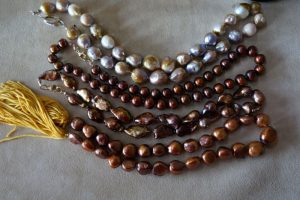
Courtesy Helen Serras-Herman
5. Chocolate Cultured Pearls
Pearls are produced in both salt and freshwater marine mollusks when a tiny irritant enters the shell. The mollusk then covers it with layers of nacre (mother-of-pearl) and smoothes that irritant to either a perfectly round shape (at its best) or any off-round, baroque shape. In nature, this process is extremely rare, one in about 10,000 shells. Most pearls today are cultured. This process was first introduced in early 20th-century Japan with the classic white or cream Akoya pearls. The 21st century has seen South Sea white and golden pearls from Australia and the Philippines, and Tahitian pearls in exotic dark colors.
The vast majority of cultured pearls on the market are freshwater pearls mainly from rivers and lakes in China. Most Chinese white pearls have been bleached and most dark chocolate-brown or any other fancy color (gold, blue, pink, red, etc) are dyed. In recent years, natural-color cultured pearls that come out of the shells in beautiful natural multi-golden-creamy colors are very popular and in high demand.
Pantone’s Color of the Year influences trends in home décor, fashion, and jewelry. It’s a great way to find inspiration for new designs in the featured colors, even from the poetic names. Featuring brown gemstones and minerals that fall into that spectrum keeps our collections fresh and current.
This story about brown gemstones and the Pantone Color of the Year previously appeared in Rock & Gem magazine. Click here to subscribe. Story by Helen Serras-Herman.


